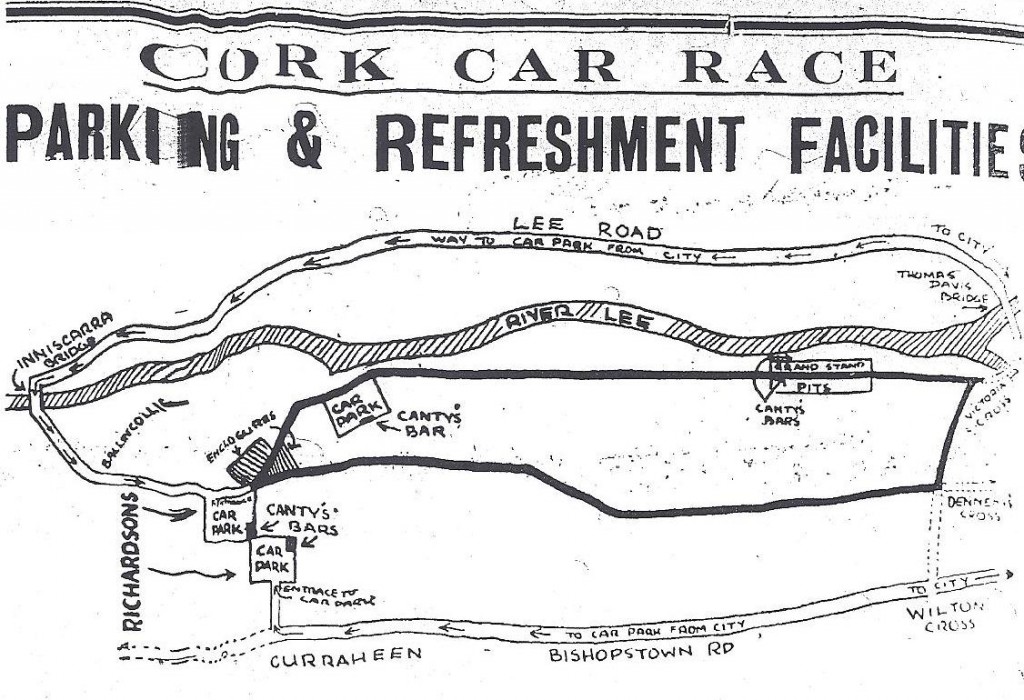
Kieran’s Our City, Our Town, Cork Independent,
24 March 2011
In the Footsteps of St. Finbarre (Part 252)
Car Race Fever, 1936
“For the first time in its chequered history, Cork is in the grip of car race fever and the fact that the vast majority of its citizens have never seen such a thing as a high speed car race abates not one jot or tittle the absorbing interest of next Saturday’s big event. Business concerns and representative citizens have subscribed generously to the financial side of the project; the men who volunteered to do the prolonged spade work of the preparations have spared no effort to achieve success and now, at the culminating point of the great endeavour, the general body of the public have entered into the spirit of hope of a great success for one of the most ambitious staged in the Southern Capital” (Journalist, Cork Examiner, 14 May, 1936, p.12)”.
In the years 1929-1931 Phoenix Park was the key venue for the Irish Grand Prix in motor car racing and was very well supported. Similarly thousands of people came out on 5 August 1935 to see the first Grand Prix race in Limerick. Inspired by the Limerick races, the people of Cork were spurred to host a similar event. The viability of organising a motor race in Cork was initially mooted by the Lord Mayor, Alderman Sean French. A committee was set up under the chairmanship of R H Tilson. They sought to develop further the populace interest in automobile sport south of the River Shannon and to investigate the benefit it would have to the City of Cork and the surrounding area. The Royal Irish Automobile Association (IMRC) were written to. Formed in 1901, they are now one of the oldest motor clubs in the world. They were asked them to be promoters of the planned Cork race. The Government Roads Department and Cork County Council invested in bringing the chosen circuit in the Carrigrohane Straight Road area up to the required standard for the running of such an event. The Cork business community also invested in getting the project up and running.
The Cork Examiner on the Thursday before the race day (which was Saturday, 16 May 1936), had an extensive written spread on the event. The distance of the track was 201 miles or 33 laps of the circuit. The starting time was 3.30pm and the estimated time of the race was two hours and twenty minutes. Practice was held over the two days previous to the race. The race was a handicap one, the handicap consisting of credit laps and time penalties. The cars started in four groups, one with the fall of the flag and the other three at one minute intervals. The prize fund totalled £650. The direction of the race was citywards as far as Victoria Cross, then to Dennehy’s Cross and the Model Farm Road. The back stretch finished at the Poulavone hairpin bend, on the main Ballincollig Road; for this point the cars proceeded citywards, passing the old Carrigrohane railway station and so into the straight. In anticipation of the high speeds on the concrete stretch, a white line was drawn ten feet from the right hand kerb. The slower cars had to keep inside this line, except when passing out.
Being the first time, the venture was run in Cork, the race was not granted international status. An entry of twenty-seven was received. The most famous of the drivers was Austin Dobson, of Surrey, who piloted the Alfa-Romeo, in which the Italian ace Nuvolari won the German Gran Prix in July 1935. This car was reputed to be the fastest ever seen in Britain and Ireland, being capable of speeds up to 180 miles per hour, and in it Dobson was hopeful to set a new record. He already held the Phoenix Park record with 99.6 m.p.h.
Austin Dobson was partnered by two other well known drivers from Brooklands, motor racing circuit in Surrey, England Charles Edward Capel Martin and A Powess-Fyffe. At Donnington Charles Martin broke the lap record three times and set up new figures for ten laps. Powess, who was a newcomer to Free State Racing, had many Brooklands successes to his credit. Brooklands was a 2.75-mile (4.43 km) motor racing circuit and aerodrome built near Weybridge in Surrey, England. It opened in 1907, and was the world’s first purpose-built motorsport venue, as well as one of Britain’s first airfields. The circuit hosted its last race in 1939, and is today home for the Brooklands Museum, a major aviation and motoring museum, as well as a venue for vintage car, motorcycle and other transport-related events.
The majority of the English drivers who came for the Cork race arrived from Fishguard on the MV Innisfallen. They were greeted by Major Neill McNeill, President of the Irish Motor Racing Club, Mr. D J Scannell, secretary, Mr R H Tilson, Chairman of the organising committee of the race and many members of the committee. The drivers’ cars and racing kit were taken ashore. All the racing cars were subsequently conveyed to the Fordson factory on The Marina, where their official scrutiny was conducted by the officials of the Irish Motor Racing Club. Whilst waiting, the visitors got a tour of the Fordson Plant.
To be continued…
Captions:
583a. Motor Car Racing on the Carrigrohane Straight, 14 May 1936 (source: Wilford J. Fitzsimmons book The Cork Motor Races, 1936-1938)
583b. Rough sketch map of the 1936 Motor Car Race in the Carrigrohane Straight Road area by The Cork Examiner, 14 May 1932, p.12 (source: Cork City Library)
